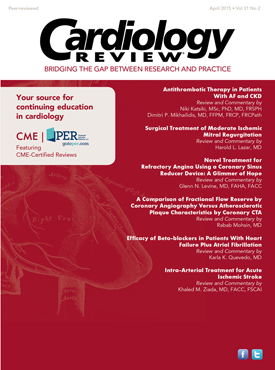Publication
Article
Cardiology Review® Online
Glycemic Control and Excess Mortality in Patients with Type 1 Diabetes Mellitus
Author(s):
Mortality in patients with type 1 diabetes mellitus (T1DM) is higher than in the general population, and whether mortality improves or alters with glycemic control is unknown.

Sucheta Gosavi, MD
Mortality in patients with type 1 diabetes mellitus (T1DM) is higher than in the general population, and whether mortality improves or alters with glycemic control is unknown.
In their article “Glycemic Control and Excess Mortality in Type 1 Diabetes Mellitus,” Marcus Lind, MD, and colleagues conducted an observational study in the Swedish population in patients with type 1 diabetes mellitus (T1DM) to determine the mortality rate and causes of death in this population.1
Study Details
A total of 33,915 patients with T1DM were followed from January 1, 1998 to December 31, 2011. For each diabetic patient, 5 controls were randomly selected from the general population and matched according to age, sex, and county. A total of 169,249 controls were followed for a similar period. Mean age of the patient population and control population was 35 years; 45% of each group was female.The educational level of the patients and controls was also similar in the 2 groups.
T1DM was defined on the basis of epidemiologic data: definite diagnosis of diabetes mellitus at 30 years or younger, and treatment with insulin. An updated mean glycated hemoglobin (A1C) that was an average of 3 values of A1C done during the study period was used. Two renal variables were used to compare mortality between patients and controls, with the first categorized as normoalbuminuria, microalbuminuria, macroalbuminuria, or stage 5 chronic kidney disease (CKD), and the second categorized as an eGFR of 15 to <60 mL/min, between 60 and 120 mL/min, or >120 mL/min.
Cox regression models were used in the statistical analysis. The study results revealed that mortality rate for patients with T1DM was 8%, and for control, 2.9%. Hazard ratios for death from any cause and death from cardiovascular causes among patients with T1DM versus controls were 3.52 (95% CI, 3.06-4.04) and 4.60 (95% CI, 3.47-6.10), respectively, after adjustment for age, sex, duration of diabetes, educational level, and prior cardiovascular disease.
Analyses showed that the mortality from any cause and from cardiovascular diseases increased with higher A1C, but even with good control of A1C (<6.9%) there was a significantly excessive risk of death from any cause and cardiovascular diseases. It was also noted that advanced kidney disease (stage 5 CKD) was an added risk for overall mortality and cardiovascular mortality. Other causes of death were related to diabetic ketoacidosis or hypoglycemia.
Thus, the authors of this study concluded that not only does mortality increase along with A1C level, but in T1DM with normoglycemia, the risk of death from any cause and the risk of death from cardiovascular causes were still double that of the general population. In patients with poorly controlled blood sugars and elevated A1C, the risk of death from cardiovascular causes was 8 to10 times higher. Also, women with T1DM were observed to have higher risk of mortality from cardiovascular diseases. In addition, the risk of death for patients with T1DM and stage 5 CKD was 30 times higher than among controls. Among the limitations of the study was the fact that that not all patients had completed records of A1C levels. Furthermore, some controls had type 2 diabetes mellitus (T2DM), which could have affected the statistical analysis.
The researchers conclude that even with euglycemia, mortality among patients with T1DM remains higher. The questions include: does cardiovascular or renal disease develop prior to the onset of T1DM, and are there any causes beyond the macrovascular/microvascular disease that increases mortality? Or do hypoglycemic episodes or diabetic ketoacidosis commonly noted among patients with T1DM affect mortality?
T1DM is mostly a disease diagnosed in childhood, though a few cases are diagnosed in early adulthood. The Diabetes Control and Complications Trial/Epidemiology of Diabetes Intervention and Complications (DCCT/ EDIC) study has shown a sustained decrease in the development and progression of microvascular complication with euglycemia achieved with intensive therapy in T1DM patients.2 This same cohort was subsequently followed for 17 years by Nathan et al,3 who showed that the intensive glucose therapy reduced cardiovascular events by about 57%. Nathan et al also noted that intensive glucose therapy should be implemented early in life, and if sustained over a lifetime can affect cardiovascular events favorably.
Recently, a study by Orchard et al4 reported results of a 27-year follow-up of a cohort of the DCCT/EDIC study. The authors analyzed total and cause-specific mortality, and reported that mortality risk calculated per 100,000 patient-years was lower in the intensive group. This mortality benefit was significant after 15 years of follow-up. The most common cause of death in this study was also related to cardiovascular events and albuminuria; advanced kidney disease was associated with increased risk of mortality. During the follow-up, it was noted that mean A1C was increased in the intensive group. It has been noted that most patients have difficulty maintaining a perfect A1C over their lifetime. Despite that, mortality has been lower in the intensive therapy group. Thus, even a few years of maintaining excellent control of A1C was associated with sustained long-term benefits on mortality.
Conclusion
Studies have shown that excess mortality in T1DM is seen in patients with albuminuria5 and that intensive therapy for even a few years results in subsequent reduction in mortality later in life (referred to as “metabolic memory”6). In conclusion, even though conflicting data exist on the mortality benefits of intensive blood glucose control, it has been shown to improve cardiovascular events, which is the major cause of death in people with T1DM.
References
1. Lind M, Svenson AM, Kosiborod M, et al. Glycemic control and excess mortality in type 1 diabetes. NEnglJMed. 371:12:1972-1983.
2. Diabetes Control and Complications Trial Research Group. The effect of intensive treatment of diabetes on the development and progression of long-term complications in insulin dependent diabetes mellitus. N Engl J Med. 1993:329:977-986.
3. Diabetes Control and Complication Trial/Epidemiology of Diabetes Interventions and Complications (DCCT/ EDIC) Study Research Group. Intensive diabetes treatment and cardiovascular disease in patients with Type 1 DM. N Engl J Med. 2005:358(25):2643-2653.
4. Orchard TJ, Nathan DM, Zinman B,et al; Writing Group for the DCCT/EDIC Research Group.Association between 7 years of intensive treatment of type 1 diabetes and long-term mortality.JAMA. 2015;313:5-53.
5. Orchard TJ, Secrest AM, Miller RG, Costacou T. In the absence of renal disease, 20 year mortality risk in type1 diabetes is comparable to that of the general population: a report from the Pittsburgh Epidemiology of Diabetes Complications Study. Diabetologia. 2010;53:2312-2319.
6. Diabetes Control and Complications Trial/Epidemiology of Diabetes Interventions and Complications Research Group. Retinopathy and nephropathy in patients with type 1 diabetes four years after a trial of intensive therapy. N Engl J Med. 2000;342:381-389.
About the Author
Sucheta Gosavi, MD, is a cardiology fellow at Texas Tech University Health Sciences Center in El Paso, TX, and was assistant professor of internal medicine there. She is board certified in internal medicine and echocardiography. Dr Gosavi received her medical degree at R.G. Kar Medical College in Kolkata, India. She completed her postgraduate studies in internal medicine in India and at the University of Missouri. Dr Gosavi was a research fellow at Massachusetts General Hospital in the cardiac ultrasound laboratory. She also has a master’s degree in tropical medicine and public health.






